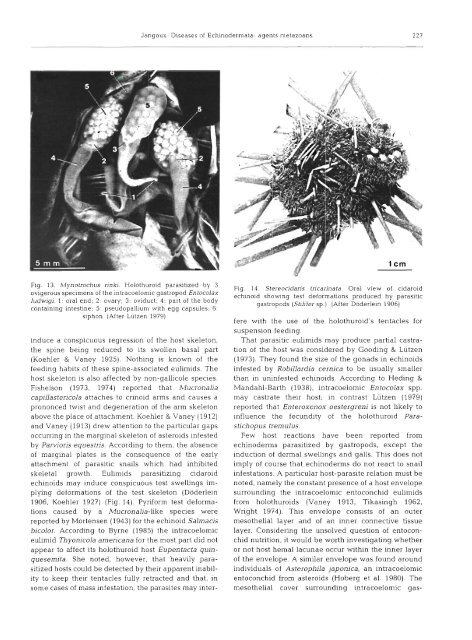Diseases of Echinodermata. 11. Agents metazoans ... - Inter Research
Diseases of Echinodermata. 11. Agents metazoans ... - Inter Research
Diseases of Echinodermata. 11. Agents metazoans ... - Inter Research
You also want an ePaper? Increase the reach of your titles
YUMPU automatically turns print PDFs into web optimized ePapers that Google loves.
Fig. 13. Myriotrochus rinki. Holothuroid parasitized by 3<br />
ovigerous specimens <strong>of</strong> the intracoelomic gastropod Entocolax<br />
ludwigi. 1: oral end; 2: ovary; 3: oviduct; 4: part <strong>of</strong> the body<br />
containing intestine; 5: pseudopallium with egg capsules; 6:<br />
siphon. (After Liitzen 1979)<br />
induce a conspicuous regression <strong>of</strong> the host skeleton,<br />
the spine being reduced to its swollen basal part<br />
(Koehler & Vaney 1925). Nothing is known <strong>of</strong> the<br />
feeding habits <strong>of</strong> these spine-associated eulimids. The<br />
host skeleton is also affected by non-gallicole species.<br />
Fishelson (1973, 1974) reported that Mucronalia<br />
capillastericola attaches to crinoid arms and causes a<br />
prononced twist and degeneration <strong>of</strong> the arm skeleton<br />
above the place <strong>of</strong> attachment. Koehler & Vaney (1912)<br />
and Vaney (1913) drew attention to the particular gaps<br />
occurring in the marginal skeleton <strong>of</strong> asteroids infested<br />
by Parvioris equestris. According to them, the absence<br />
<strong>of</strong> marginal plates is the consequence <strong>of</strong> the early<br />
attachment <strong>of</strong> parasitic snails which had inhibited<br />
skeletal growth. Eulimids parasitizing cidaroid<br />
echinoids may induce conspicuous test swellings im-<br />
plying deformations <strong>of</strong> the test skeleton (Doderlein<br />
1906, Koehler 1927) (Fig. 14). Pyriform test deforma-<br />
tions caused by a Mucronalia-like species were<br />
reported by Mortensen (1943) for the echinoid Salmacis<br />
bicolor. According to Byrne (1985) the intracoelomic<br />
eulimid Thyonicola arnericana for the most part did not<br />
appear to affect its holothuroid host Eupentacta quin-<br />
quesemita. She noted, however, that heavily para-<br />
sitized hosts could be detected by their apparent inabil-<br />
ity to keep their tentacles fully retracted and that, in<br />
some cases <strong>of</strong> mass infestation, the parasites may inter-<br />
Jangoux: <strong>Diseases</strong> <strong>of</strong> <strong>Echinodermata</strong> agents n-~etazoans 227<br />
Fig. 14, Stereocjdaris tricarinata. Oral view <strong>of</strong> cidaroid<br />
echinoid showing test deformations produced by parasitic<br />
gastropods (Stilifer sp.). (After Doderlein 1906)<br />
fere with the use <strong>of</strong> the holothuroid's tentacles for<br />
suspension feeding.<br />
That parasitic eulimids may produce partial castration<br />
<strong>of</strong> the host was considered by Gooding & Liitzen<br />
(1973). They found the size <strong>of</strong> the gonads in echinoids<br />
infested by Robillardia cernica to be usually smaller<br />
than in uninfested echinoids. According to Heding &<br />
Mandahl-Barth (1938), intracoelomic Entocolax spp.<br />
may castrate their host; in contrast Liitzen (1979)<br />
reported that Enteroxenox oestergreni is not likely to<br />
influence the fecundity <strong>of</strong> the holothuroid Paras<br />
tichop us trem ul us.<br />
Few host reactions have been reported from<br />
echinoderms parasitized by gastropods, except the<br />
induction <strong>of</strong> dermal swellings and galls. This does not<br />
imply <strong>of</strong> course that echinoderms do not react to snail<br />
infestations. A particular host-parasite relation must be<br />
noted, namely the constant presence <strong>of</strong> a host envelope<br />
surrounding the intracoelomic entoconchid eulimids<br />
from holothuroids (Vaney 1913, Tikasingh 1962,<br />
Wright 1974). This envelope consists <strong>of</strong> an outer<br />
mesothelial layer and <strong>of</strong> an inner connective tissue<br />
layer. Considering the unsolved question <strong>of</strong> entoconchid<br />
nutrition, it would be worth investigating whether<br />
or not host hemal lacunae occur within the inner layer<br />
<strong>of</strong> the envelope. A similar envelope was found around<br />
individuals <strong>of</strong> Asterophila japonica, an intracoelomic<br />
entoconchid from asteroids (Hoberg et al. 1980). The<br />
mesothelial cover surrounding intracoelomic gas-

















